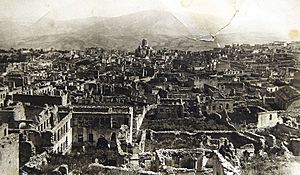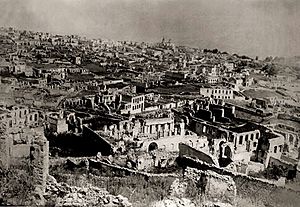Shushi Massacres facts for kids
The Shushi massacres were terrible attacks against Armenians during a war between Armenia and Azerbaijan in 1920. Soldiers from Azerbaijan and Turkey, along with Kurdish groups, attacked the people living in the city of Shushi. These events happened from March 22 to March 26, 1920. More than 20,000 Armenians died, and the city of Shushi in Nagorno-Karabakh was destroyed.
Contents
What Led to the Events in Shushi?
In June 1919, there was a fight between Armenian and Turkish groups in Shushi. This conflict was started by Khosrov beg Sultanov, who was the Governor-General of Azerbaijan at the time. The city was blocked off, which meant people could not get food. This made life very hard for the Armenian people living there.
The Attacks on Shushi (March 22-26, 1920)
At the start of 1920, Governor Sultanov broke a peace agreement made in August 1919. He continued to block off the region of Karabakh. He also sent more soldiers to important places and gave weapons to the local Azeri people.
Early on March 23, 1920, Azeri soldiers and Kurdish groups attacked the Armenian part of Shushi. They began a terrible attack on the Armenian people. These attacks continued until March 26, 1920.
Remembering the Tragedy
Many people have remembered the events in Shushi.
The famous Russian poet Osip Mandelstam visited Shushi in 1931. He wrote a poem called "The phaeton driver" about this sad event:
So in Nagorno-Karabakh
These were my fears Forty thousand dead windows Are visible there from all directions, The cocoon of soulless work Buried at the mountains.
On July 1, 1997, Baroness Caroline Cox gave a speech in the House of Lords in the United Kingdom. She spoke about the Armenians who were killed, and she specifically mentioned the events in Shushi in 1920.
A researcher named Kalli Raptis wrote about it in her book Nagorno-Karabakh and the Eurasian Transport Corridor. She explained that in July 1918, the First Armenian Assembly of Nagorno Karabakh said the region was self-governing. They created their own council and government. In August 1919, the Karabakh national Council made a temporary agreement with the Azerbaijani government. This was to avoid a fight with a stronger opponent. However, Azerbaijan broke this agreement. This led to the massacre of Armenians in Shushi, the capital of Nagorno-Karabakh, in March 1920.
See also
 In Spanish: Pogromo de Shusha para niños
In Spanish: Pogromo de Shusha para niños



